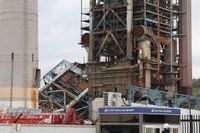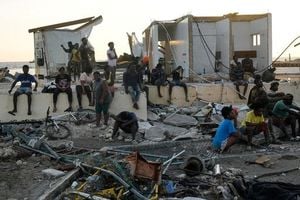In the southeastern city of Ulsan, South Korea, a grim scene has unfolded at the site of a decommissioned thermal power plant, where a 60-meter-tall boiler tower collapsed during demolition work on November 6, 2025. The accident has left three workers confirmed dead, with at least two others presumed dead and still missing beneath the tangled wreckage. As of Saturday, November 8, search and rescue efforts persisted, with authorities scrambling to locate the remaining trapped workers and navigate a hazardous, debris-strewn landscape.
The collapse occurred as nine workers were on site, preparing the decades-old structure for demolition. According to the Associated Press, two workers were pulled to safety shortly after the collapse, but tragedy soon followed: one of the rescued workers was pronounced dead at a hospital early the next morning. Over the subsequent hours, rescue teams recovered two more bodies from the rubble, with a site doctor confirming the deaths. The fate of two others remains uncertain, but officials fear the worst.
Search operations have been anything but straightforward. Kim Jeong-shik, an official with Ulsan's fire department, described the scene in stark terms during a briefing: "The rescue site is currently covered with large amounts of asbestos and glass fibres … and the space is extremely cramped, forcing rescue workers to manually clear the debris by hand in order to carry out the rescue operations." The sheer volume of hazardous materials and the confined quarters have made the mission perilous, with workers relying on their hands, search dogs, thermal cameras, and endoscopes to probe the wreckage.
More than 340 rescue workers and about 90 vehicles and pieces of equipment have been deployed to the site, according to Mathrubhumi. Their efforts have been further complicated by the weather; on the third day of the search, rain briefly fell, making the already treacherous conditions even more challenging. Firefighters have been working through roughly 30 meters of twisted steel and debris to reach the heart of the collapse, deploying about 40 rescuers and using drones and other high-tech equipment overnight, as reported by Korea Herald.
The boiler tower, once a central feature of the Ulsan branch of the Korea East-West Power Co.—a state-run utility—was in the process of being demolished, its operational life having ended in 2021 after 40 years of service. The accident took place as subcontractor workers were cutting steel supports to weaken the tower in preparation for blasting work. As the supports gave way, the structure collapsed, trapping those working below.
Authorities have moved swiftly in response. South Korean President Lee Jae Myung instructed officials to mobilize all available personnel and resources while emphasizing the safety of those involved in the rescue. Prime Minister Kim Min-seok visited the disaster site to inspect ongoing operations and later met with the bereaved families at a funeral home, offering condolences and support. The central disaster and safety response headquarters decided to dismantle the adjacent Units 4 and 6—nearby power plant structures that had also been weakened for demolition—to facilitate rescue operations and prevent further collapse. Preparatory blasting work for these units began on the night of November 7, with demolition expected to occur early the following week, likely on Tuesday, November 11.
"Access is very difficult because there are steel beams inside the structure," Kim Jeon-sik, an official of the Ulsan Southern Fire Station, told reporters. "There are limits (to the search operation) with the current equipment." Despite these obstacles, the mood among rescue teams has remained determined, if somber. The hope of finding survivors has faded with each passing hour, but the urgency to recover the missing and bring closure to their families has not diminished.
Meanwhile, the Ulsan District Prosecutors Office has launched a formal investigation into the incident, working in cooperation with police and the labor ministry. Their mandate is twofold: to determine the precise cause of the collapse and to assess whether proper safety measures—such as supporting the tower with wires—were in place at the time of the accident. The investigation team has also pledged to hold any responsible parties accountable and to provide support to the victims' families.
The question of safety protocols looms large. With demolition work inherently dangerous, the process typically requires meticulous planning and robust safeguards. Whether these standards were upheld in Ulsan is now at the heart of the probe. The fact that the boiler tower had already been weakened for demolition raises concerns about whether the structure was adequately stabilized and what precautions, if any, were taken to protect workers during the critical phase of cutting steel supports.
For the local community, the disaster has been a sobering reminder of the risks faced by workers in heavy industry—a sector that has long powered South Korea's economic growth but has also seen its share of tragedies. The plant itself, decommissioned after four decades, was a symbol of the country's industrial might. Its dismantling was supposed to mark the end of an era, not the start of a new chapter of loss.
As the rescue and recovery operation enters its next phase, attention has also turned to the broader implications of the accident. Will this tragedy prompt a re-examination of demolition practices across the nation? Will it lead to tougher enforcement of safety standards or new regulations to protect workers in similar settings? These are questions that policymakers, labor advocates, and the public alike are now grappling with.
For now, the focus remains on the immediate task at hand: finding the missing, supporting their families, and learning the hard lessons that such disasters inevitably teach. The combined efforts of hundreds of rescue workers, the deployment of advanced technology, and the commitment of national leaders all reflect the gravity of the situation—and the determination to see it through to the end.
As the days pass and the debris is slowly cleared, the hope is that answers will emerge from the rubble, providing not only closure for those directly affected but also a pathway to safer practices in the future.




